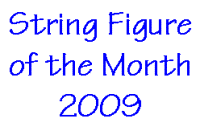A Centipede
Collected by Frederick McCarthy from the Yirrkala Aborigines of Arnhem Land, Australia. Yirrkala figures often include "twine" motifs: two strings twisted together. Other examples include figures that represent a lobster, a scorpion, two boomerangs, and two stingrays. The Congo in Africa is the only other location where the "twine" motif is popular.
<Full-length video in Windows Media Player>
Step-by-Step Video Clips
|
Written Instructions | |


© 2009 ISFA. All rights reserved. |
Step 8 - 1 hooks down the string that forms the lower outer side of the nearest diamond; in the process the original 1 loop slips off.
As you extend the figure with palms facing away, the 4-diamond pattern rearranges itself in a surprising way to create a second design that represents "A Centipede". According to McCarthy's informant the left palmar knot represents the creature's head, the right palmar knot represents its tail, and the "twine" motif along the lower frame line represents its underbelly. |
